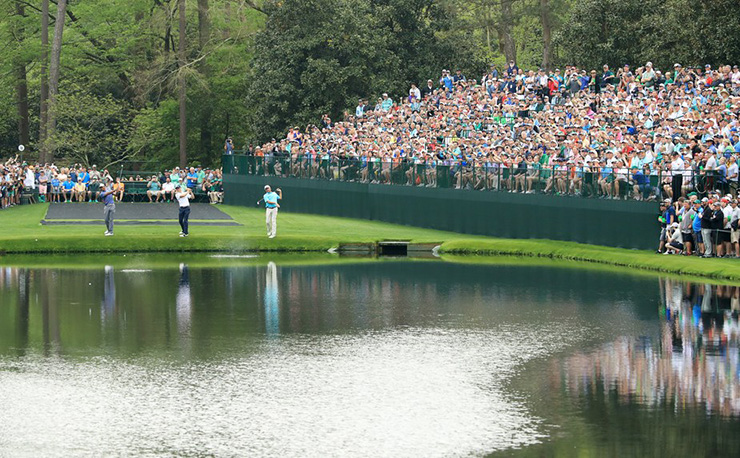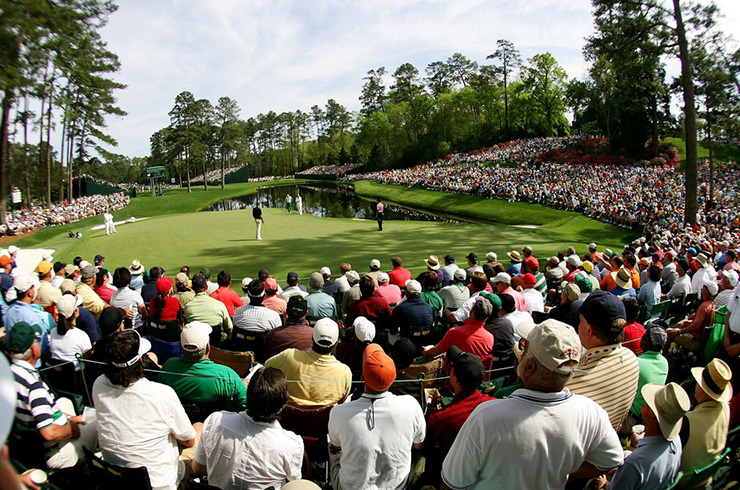By Joel Beall
He is at the world’s most famous course at its famed event, and the sport’s most famous face is in front of him. But Jay DiPali does not seem to care in the least. As Tiger Woods hits his tee shot at the 16th hole, his head is swivelling every which way but the one it should be pointed.
That is until Woods, and partners Justin Thomas and Fred Couples, depart the tee box, which grabs DiPali’s attention. With fire in his belly and beer on his breath, he barks, “Skip. Skip! SKIP!” He is joined in unison by his friends and the thousand or so patrons surrounding the hole, per tradition. And their pleas are heard: Woods, Thomas and Couples ricochet their balls off the pond and onto the green. Cheers go up, and DiPali produces a glowing nod.
He then returns to the predicaments that have vexed him so, which appears to be the prospect of an empty cup (a gulp or two away from fruition) and whether the cadre of girls they were supposed to meet will show.
“Flow, killer,” says DiPali of Columbia, S.C., resigning himself to the fate that he and his buds have been stood up. He says this with no trace of glib, because—in spite of the panorama that lies before him—he holds it as true. Also a fit of pique: the lack of sundresses in the early morning. “Just killing my morning.”
It’s a line that will make many of this tournament’s obsessives—especially those not on property this week, their lottery bids unfulfilled, their quests for a secondary-market badge in vain—bite their putters in agony. But a line that speaks to a certain, and growing, sect of patrons at the Masters. More specifically, the area they congregate.
—
On the whole, the patrons at Augusta National are a different profile from the modern fan. They are well-informed, attentive, reserved, respectful, stemming from Bobby Jones’ standing mandate on behaviour at the Masters.
“In golf, customs of etiquette and decorum are just as important as rules governing play,” wrote Jones in 1967. “It is appropriate for spectators to applaud successful strokes in proportion to difficulty but excessive demonstrations by a player or his partisans are not proper because of the possible effect upon other companies. Most distressing to those who love the game of golf is the applauding or cheering of misplays or misfortunes of a player. Such occurrences have been rare at the Masters but we must eliminate them entirely if our patrons are to continue to merit their reputation as the most knowledgeable and considerate in the world.”
This edict still serves as the M.O. of the tournament. Well, at least over most of its domain. At the edges of the delicate Masters ecosystem resides the 16th hole, an area that can be decidedly un-Augusta.
For many, golf is not the draw of the 16th; it’s the atmosphere. What they know about the sport—or more specifically, what they don’t—hammers that sentiment home. While Woods was on the 15th, four adult men, for the life of them, could not remember who won last year’s Masters, saved by the polite sigh of “Patrick Reed” from a volunteer. (Whether the sigh was at their ignorance or the divisive nature of the champ is anyone’s guess.) Most patrons name their canines Juniper, White Dogwood and Redbud; the average fan on the 16th thinks these are Jersey Mike’s subs.
Instead, the 16th is the place to be seen, to converse, to party. Especially to party.
“Why go anywhere else?” replies Bob Rummel, full drink in hand. “It sizzles here.” And wobbles, as a host of patrons are clearly enjoying their share of the spirits.
To be fair, there’s an inherent acceptance in 2019 that hosting a sporting event means entertaining non-sports fans. That’s why hospitality boxes are so important to new arenas, why ballparks have breweries and playgrounds attached to their diamonds. It applies to Augusta National, found in Berkman’s Place.
But Berkman’s is for businessmen and VIPs; there’s not a specifically designated socializing area for the common man. So, over the years, they made the 16th their own.
“It’s just people being themselves out here,” DiPali said, rejuvenated at the sight of newly-arrived co-eds. “You feel like you’re going to get yelled at, but here is just different.”

Andrew Redington
Scholars debate when it started—the club itself isn’t sure, and Tom Kite, Lee Trevino and Ken Green have all taken credit for it—but it’s generally accepted that skipping a ball off the 16th pond came to prominence in the late ‘80s. The patrons loved the magic trick and soon called on the entire field to take part in the act.
Only the feeling wasn’t reciprocated, with many players, ahem, skipping the request. Davis Love III was chief among the detractors, feeling the practice went against what Jones and Augusta National co-founder Cliff Roberts had in mind.
“I didn’t think it was in the tradition of the Masters,” Love told Golfweek in 2016.
But the petitions persisted, and slowly the players succumbed to the cries. That included Love, who eventually joined in. His reasoning? “I started getting booed.”
“Once you understand that there are a bunch of fans that sit there all day and that’s the only day they come to the Masters, you realize this is good entertainment for them,” Love said. “And if all the chairmen haven’t stopped it, then I guess it’s OK.”
It is, in ways, peculiar, as those that encircle the 16th echo DiPali’s ambivalence towards the practice shots but become super invested once the player stride towards the water. Imagine a basketball crowd watch Steph Curry hit three after three in warm-ups, only to plead the Warriors star to play hacky sack with the ball.
Don’t get us wrong; it is cool to see a player glide a shot over the drink and onto the pristine green, but its novelty wears thin relatively quickly. At least to us; to the masses that flock to the 16th, it’s hypnotic.
“I’ve watched this 13 years and I still don’t know how they do it,” says Mark Little, 44. “Every time one lands on the green we (the crowd) react like it’s the first time.”
At a tournament, at a course, known for its restrictive ways, a bit of silliness can sometimes be welcomed. A silliness the 16th gallery is happy to emit.
“It’s just golf, right,” replies Brandon Hoffmeyer.

Harry How
Mentioned above, it is masses that come to the 16th. Aside from the 18th green on Sunday, the 16th is the hot spot for patrons to run briskly walk their folding chairs to set up shop. Though a chair’s placement allows its patron to explore the property, few do, camping out all day, even during the tournament, hours before the action arrives.
Not that they care. The 16th isn’t so much a hole as a picnic area, with the occasional group of golfers treated like a frisbee that happened to roll through.
Yes, there’s an inflection of Southern fraternity on the 16th; there’s no shortage of pastel golf shirts and Ray-Ban croakies. But there are also groups of women, young and old, who take in the proceedings. Parents bring their kids to watch the skips, while a share of middle-aged men have left their VIP confines for the scene.
“It’s the nicest place to sit and just be,” says Mary Weisenburg of Jacksonville. “So comfortable.”
Though it’s more animated than the rest of the course, it’s not like it’s Scottsdale. “No unruliness here,” a security guard said. “Maybe more vocal. Hardest part is getting (them) to stand still.”
Nevertheless, the question persists: Why come if you’re not interested in the golf? Out of a dozen or so surveyed, six patrons paid for their entrance, the cheapest badge going for $450 for the day. There’s no doubt Augusta National is the place to be, but does that apply to those whose favourite golfer is Happy Gilmore?
Apparently, yes.
“My friends said this was something you have to do, a bucket list thing,” Matt Lane of New York City said. “The place is gorgeous, and now I say I did it and bring back this (pointing to merchandise purchases), it was worth it.” Add a 20-something woman by his side: “Everyone is so friendly. You can just do whatever.”
Hey, who said Augusta National is restrictive?
Not to say the 16th lacks actual golf merit. It’s a beastly 170 yards, guarded by the aforementioned pond and three bunkers, with anything from an eagle to double in triple in play. That it’s routinely the site of historic Masters highlights doesn’t hurt its appeal.
Assuming, of course, that patrons are paying heed to what’s going on inside the ropes. At this moment, with the sun breaking through the morning’s overcast and bringing those promised sundresses, the patrons of the 16th are more concerned what’s going on outside them.
“What a place to be, right?” DiPali says with a devil-curling smirk.









